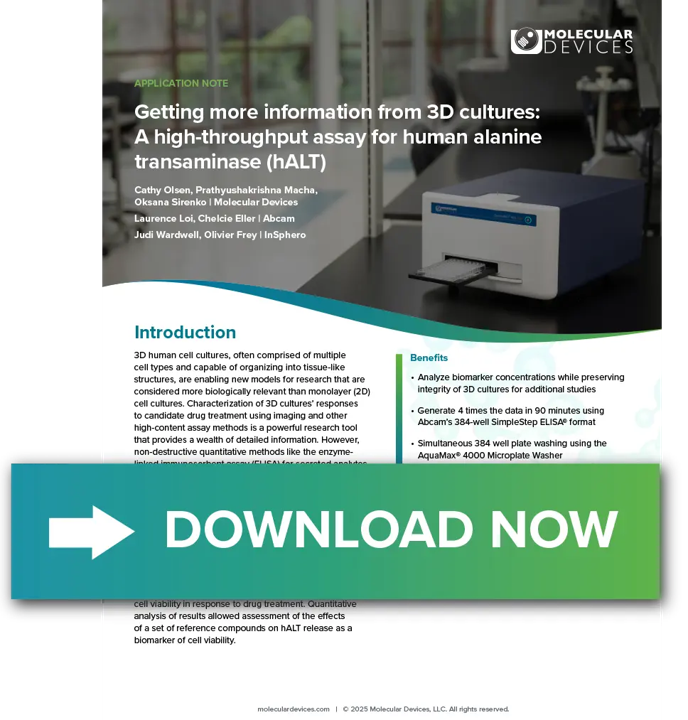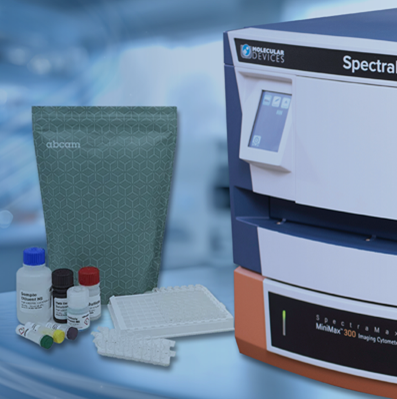

Breaking Bottlenecks in Biomarker Discovery: How Automation and Integration Are Accelerating Progress
Biomarker discovery is critical for successful clinical development, yet many researchers face familiar challenges: slow assays, manual workflows, inconsistent data, and tools that don’t “talk” to one another. From early-stage screening to validation, these bottlenecks often lead to lost time, sample waste, and missed deadlines.
But what if the tools worked as a team?
That’s the promise of combining validated assay kits, automation-ready microplate readers, and integrated software. Together, they streamline complex workflows, reduce variability, and allow scientists to focus more on discovery rather than repetitive manual steps.
The Problem: Slow Assays, Manual Steps, and Inconsistent Data
Biomarker discovery is essential for drug development and translational research, but many workflows are slowed down by:
- Labor-intensive ELISA protocols with multiple wash and incubation steps
- Data inconsistencies caused by incompatible kits, readers, and software
- Reproducibility challenges when scaling to higher throughput
Together, these issues lead to wasted time, lost samples, and missed deadlines.
What if validated assays, automation-ready instruments, and integrated data analysis could work together to eliminate these bottlenecks?
The Solution: Automation, Validated Kits, and Integrated Analysis
Molecular Devices and Abcam have partnered to bring together the three key components of an integrated workflow:
- Automation-ready instrumentation that fits seamlessly into high-throughput environments
- Validated SimpleStep ELISA® kits that reduce assay time without sacrificing sensitivity
- Integrated data analysis software that ensures consistency, compliance, and faster reporting
This approach was recently put to the test in a Human ALT (hALT) liver toxicity study — demonstrating how these solutions can transform biomarker workflows.
Case Study: Quantifying ALT in a 3D Liver Microtissue Model
Why ALT?
Alanine aminotransferase (ALT) is a key biomarker for detecting drug-induced liver injury. Traditional ELISAs for ALT measurement can take several hours, require larger sample volumes, and involve multiple wash steps — slowing throughput and increasing variability.
Study Design
Researchers used Abcam’s Human ALT SimpleStep ELISA® kit in combination with Molecular Devices’ automation tools to measure liver toxicity biomarkers in 3D microtissue cultures.
- Model: 3D human liver microtissues in 384-well format
- Sample Collection: 25 μL supernatant per well, diluted 1:2 before assay
- Assay: Abcam’s Human ALT SimpleStep ELISA® kit (ab234578), single-wash, 90-minute protocol
- Automation Integration:
- Washing performed with the AquaMax® 4000 Microplate Washer (384-well wash head)
- Detection with the SpectraMax® ABS Plus Reader, reading 8 wells at once for faster acquisition
- Data Analysis: Curve fitting and reporting in SoftMax® Pro Software
Results
- Throughput: 384-well format delivered 4× more data compared to traditional 96-well plates in the same timeframe
- Sample Preservation: ALT was quantified directly from supernatants without destroying the microtissues, saving biological material for follow-up studies
- Efficiency: Assay time reduced to ~90 minutes with up to 60% less hands-on time than traditional ELISAs
- Reproducibility: Automation integration minimized variability, improving consistency across replicates
By embedding validated kits into an automated workflow, researchers accelerated biomarker discovery without sacrificing sensitivity or reproducibility. To learn more about this study, download our poster, “Getting more information from organoids: A high-throughput assay for human alanine transaminase (hALT)”
Why This Matters for Biomarker Research
The hALT study illustrates how automation and integration can directly overcome common bottlenecks in biomarker discovery:
- Miniaturization without compromise – moving from 96-well to 384-well formats boosts throughput while reducing sample volume needs.
- Automation reduces error – automated washing and automated detection minimize human error and variability.
- Validated kits simplify workflows – single-wash ELISAs maintain sensitivity while cutting down assay time.
This approach allows researchers to scale biomarker studies more confidently and efficiently — whether for toxicology, oncology, or immunology applications.
Core Components of an Integrated Biomarker Workflow
1. Automation-Ready Readers
SpectraMax® multi-mode microplate readers are designed to integrate seamlessly into automated workflows making them ideal for high-throughput ALT quantification. Whether you're running high-throughput ELISAs or measuring cell viability, these readers offer:
- Walkaway operation with automation compatibility
- GxP-compliant data capture via SoftMax® Pro GxP Software
- Multiple detection modes, including absorbance, fluorescence, luminescence, FP, TRF, and ScanLater® western blot detection

[Figure 1. The SpectraMax i Series readers have a number of unique features that allow scientists to get more reliable results faster than ever before, allowing them to overcome frequently encountered challenges in the lab.]
This means you can set up your workflow with fewer manual steps and reap the benefits of automation: less variability and more time for actual science.
2. Validated, Automation-Compatible Kits
Abcam SimpleStep ELISA® kits are optimized for speed and reproducibility providing automation-compatible ELISA kits for liver toxicity biomarker studies and simplifying biomarker workflows with validated kits and automation. With a single-wash, 90-minute protocol, they reduce hands-on time by up to 60% compared to traditional ELISAs—without compromising sensitivity. The assays come in standard 96-well and 384-well format suitable for single analyte studies or high-throughput screening.

[Figure 2. With SimpleStep ELISA kits, an analyte-capture and detector antibody sandwich complex is formed in solution, which binds to the microplate via an affinity tag attached to the capture antibody in the sandwich pair.]
3. Integrated Data Analysis
SoftMax Pro Software brings it all together, enabling fast and compliant biomarker data analysis with ready-to-use protocols and integrated reporting tools. With ready-to-use protocols, curve fitting, and compliance tools, it simplifies data analysis and reporting—whether you're quantifying cytokines or tracking protein expression.
Break through bottlenecks in biomarker discovery. Discover how Molecular Devices and Abcam are helping researchers move faster from screening to decision-making.
https://vids.moleculardevices.com/watch/TcbyPZHsYw8FNUS8oYQJnH
Accelerate Biomarker Discovery and De-Risk Your Pipeline
The shift to advanced models like liver organoids demands a smarter, faster workflow. To confidently validate next-generation biomarkers for liver toxicity, you need integrated solutions that eliminate manual bottlenecks and ensure data quality.
Our collaboration with Abcam delivers this by combining one-wash ELISA kits with automated, high-throughput microplate readers. This seamless system accelerates the analysis of crucial markers like hALT and ensures your data meets the highest standards for reproducibility and accuracy.

Figure 4. High-throughput ELISA. The SimpleStep ELISA in 384-well format accommodated the 384- well experimental layout used to culture and treat liver microtissues. 25-μL supernatants from each well were collected and diluted 1:2 prior to assay with the human ALT ELISA. A single wash step was performed with the AquaMax 4000 Microplate Washer equipped with a 384-well wash head that enabled simultaneous, rapid washing of all wells.
By integrating automation, validated kits, and advanced data analysis, researchers can:
- Reduce hands-on time and variability
- Increase throughput without compromising sensitivity
- Preserve precious samples for further experimentation
- Move faster from early screening to validated biomarker decisions
See the Technology in Action: Non-Destructive Biomarker Quantification

Learn exactly how to combine human liver organoids, automated liquid handling, and hALT ELISA kits for superior, high-throughput toxicity screening without destroying your precious samples.
DOWNLOAD THE APPLICATION NOTE: High-Throughput hALT Assay for 3D Liver Microtissues
Start Accelerating Your Discovery Today: Limited-Time Offer

Ready to integrate the hardware and reagents that will transform your biomarker validation workflow?
ACT NOW: Discover Limited-Time Offers on Readers and Assay Kits
Featuring Insights from:

Sr. Application Scientist | Molecular Devices, LLC
Cathy Olsen is a Senior Application Scientist at Molecular Devices, where she helps life science researchers accelerate biomarker discovery through automation-ready technologies. With deep expertise in assay development and workflow optimisation, Cathy plays a pivotal role in bridging scientific innovation with practical lab solutions.
Her work focuses on integrating validated ELISA kits and multi-mode microplate readers into biomarker workflows—helping researchers overcome bottlenecks, reduce variability, and improve reproducibility. Cathy is a key contributor to the Biomarkers Campaign, co-authoring thought leadership content that addresses the hidden delays in biomarker research and promotes integrated solutions for faster, more confident decision-making.

Director of Assay Development | Abcam
Chelcie H Eller is Director of Assay Development at Abcam, where she leads the innovation and optimisation of immunoassay technologies that empower researchers to accelerate biomarker discovery. With a strong focus on simplifying complex workflows, Chelcie oversees the development of Abcam’s validated ELISA and metabolism assay kits—designed for speed, reproducibility, and compatibility with automation platforms.
Her work is central to Abcam’s mission to remove bottlenecks in translational research. Chelcie collaborates closely with scientific and commercial teams to ensure that assay solutions meet the evolving needs of biotech, pharma, CROs, and academic labs. As a co-author of the Biomarkers Campaign, she champions integrated solutions that help researchers move from discovery to decision—faster and with greater confidence.